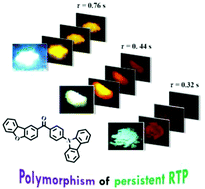Tuning the organic persistent room-temperature phosphorescence through aggregated states†
Abstract
Persistent (long-lived) room-temperature phosphorescence (pRTP) materials from a single molecule with different polymorphs are rarely reported and need to be further investigated. In the current work, we have designed and synthesized an asymmetric molecule composed of carbazole and benzofuran based D–A–D′ pRTP materials, i.e., (4-(9H-carbazol-9-yl)phenyl)(dibenzo[b,d]furan-2-yl)methanone (DBF-BZ-Cz). The compound DBF-BZ-Cz exhibits different polymorphs with various pRTP properties, including a difference in their phosphorescence color and lifetimes. The tuning of long-lived phosphorescence of a simple compound through controlling the aggregated state is shown for the first time. The color of its pRTP changed from light-yellow to orange, while its pRTP lifetime shifted from 0.76 to 0.32 s. Furthermore, it is noted that a clear negative correlation between the fractional free volume (FFV) in the crystals and the pRTP lifetime can be drawn out for the ketone derivatives. The current work demonstrates that the pRTP properties can be tuned in one single compound via controlling the aggregated states, which provides a new strategy for the investigation and application of organic long-lived phosphorescence.

- This article is part of the themed collection: 2019 Journal of Materials Chemistry C HOT Papers


 Please wait while we load your content...
Please wait while we load your content...